Besides handling it in the garden, I'm so used to buying unpackaged food items, that I feel put off when I see food of any kind being sold in a packet, jar or can. This is because of the way food is treated in Crete: we touch, we see, we smell, we sometimes even taste (for example, cheese, olives); we buy according to how it feels for us, not how it's packaged or what the labelling says. But that's not the case for spices: the variety in the spice shops of Hania is limited to the ones regularly used in local cooking. They are sold in the supermarkets and the Agora (mainly for tourists), as well as a small number of small stores in the town. Supermarkets stock all the common spices used in Greek cooking (pre-packed). Curry mixes and the like are also available, as are most internationally widespread ingredients, but if you're after something out of the ordinary, like sumac (called 'soumahi' in Greek) or spirulina, you need to buy it in a specialised shop, and always packaged in small amounts.
The town is too small to support the wholesale trade of spices in baskets and roadside hangings; in any case, most of the locals forage their own needs annually in the appropriate season. I've been given as much malotira tea as I need to last me at least another year, and I've got enough bay leaves to use for the next five years, as well as receiving precious gifts of oregano, sea salt and diktamo tea from time to time. Mint, parsley, fennel, dill and arugula are always available fresh; many people grow their own. Woody spices such as cinammon, carnation, mahleb, masticha and bahari are always available, especially during festive periods, for the purposes of baking or to spice up a special meat dish.

Bulk supplies of spices available at the supermarket over Easter for tsoureki and koulourakia; not the most enticing picture, as the fragrances lie in their plastic packages in uniform standard boxes. For the range of spices, click on the photo to see the notes.
It is difficult not to be mesmerised by the variety of colours, aromas and textures of spices, especially when they are piled high in sacks placed on the roadside, or hanging from the top of shop windows. It's impossible to pass by without stopping to admire them. As you check out the whole range offered, you discover a spice that you hadn't heard of before, or maybe something you'd read about in a cookbook or recipe; you think that it is now your chance to try it out. By the time you leave the shop, your hands are loaded with plastic shopping bags exuding exotic aromas. Your senses are exploding and you can't wait to get home and open up the packets.
Here are my recent purchases as I went in search of new tastes.
Click on the photos for notes.
Although I don't often indulge in shopping sprees, I found myself in exactly this situation on my recent trip to Athens. High fashion doesn't interest me; label clothing doesn't come in my proportions or wallet-size. When it's variety I seek, I go where my eyes can feast on food in its most basic form. It's not everyone's idea of shopping therapy, but if you're looking for real life action on the street, combined with the bright natural colours of Mediterranean food and the sights and scents that pair with it, you should head for the central Athens food market, before you enter The Spice Route.Click on the photos for notes.
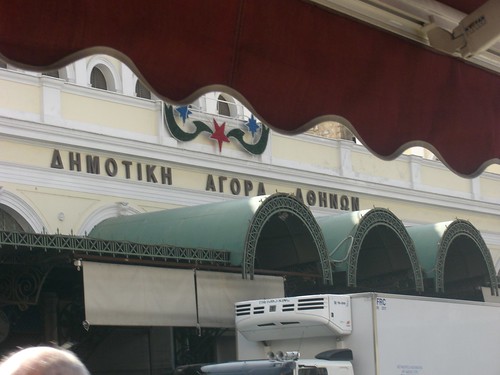
Δημοτική Αγορά Αθηνών - the central food market of Athens: not much to look at from the outside, like most other functional buildings in Greece; the truth is in the pudding. At every holiday season in Greece, the television cameras stand outside this very spot and report the prices of the festive table and the rate of trade taking place in the Agora.
If you've never taken this journey before, then I recommend that you put your faith in the gods; let them guide you through the streets of central Athens in search of ambrosia. Don't know your way around this buzzing city full of nook-and-cranny like streets, hiding in amongst the faceless apartment blocks which all sport the same blackened paint work, dirty-brown aluminium shutters and tiny balconies used to store a multitude of household items in full view of the passing pedestrians below them? Then let's meet up at a central point: let's start our walk at the well-known Syntagma Square, where the 300 modern gods of Greece convene in the Parliament buildings, directing the country into an orchestrated state of chaos.
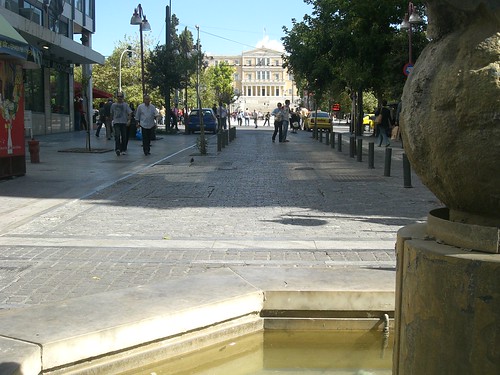
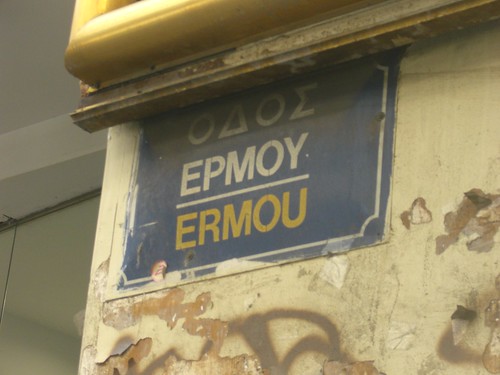
Sintagma Square with the Parliament building in the background, taken from Ermou St.
From there, let Hermes fly you across the road onto Ermou Street (Hermes, Hermou, Ermou - geddit?); join the throngs of people you will find here, but here's a warning: not everything that shines is gold. Watch out for the seductive Sirens (in the likes of BSB, Folli Follie, Raxevsky, Marks and Spencer, Sprider, et al., ad nauseam); shade your eyes and hide your purse if you fall easy prey to their dazzle and shine.
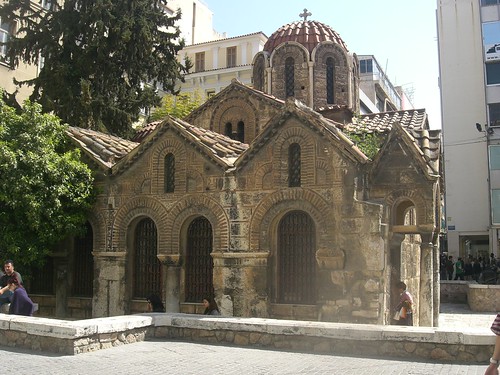
It was hard to snap the church in a moment alone; there was a lot of action on the street that day - on one side, the bag sellers; on the other, the string musicians.
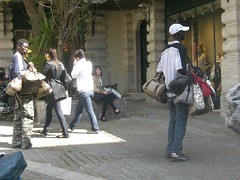
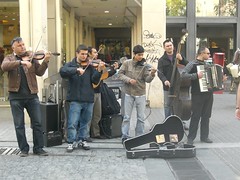
Just beyond the beautiful Byzantine monument that has been left basically intact (Kapnikarea Church), except to find the surreptitious Aeolus lurking on Aiolou Street and whipping up a storm; winds coming from all over the place will try to confuse your sense of direction. Don't be fooled by the gentle West Wind when an African bag seller entices you to buy fake Dolce Gabbanas; pretend you didn't feel the East Wind when you hear the gypsy musicians playing beautiful melodies with their string instruments. As Johnnie Walker says, just keep walking.
If you managed to do that without detouring, you will eventually meet up with the goddess of wisdom, Athena, on Athinas Street. Congratulations - you're half way there! Give yourself a well-deserved break at one of the myriads of eateries on the corner at Monastiraki; even the fast food outlets were serving lenten food the day I was there, since it was during the Great Lent before Easter.
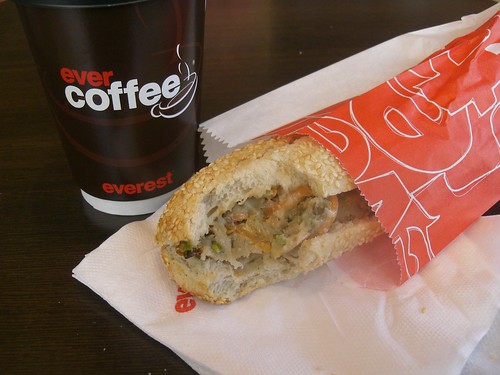
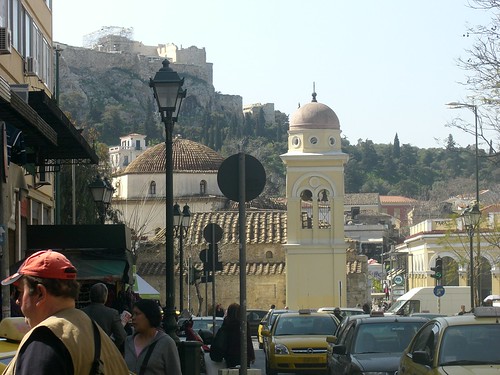
I paid a mere 4.50 euro for a coffee and this delicious lenten (read: vegan) roll with courgette fritters and salad; the view I had from where I sat was worth much more.
Once you're fed and watered, look to your left and wave to Athena in her temple rising on the rock of the Acropolis. Few people these days can get very close to the Parthenon; the Greek government only gave Nia Vardalos the right to do so just recently to film "My Life in Ruins". The Guardian - yes, it's a British newspaper - questions why the Greek government gave permission to the producers to use the Acropolis as a backdrop to the movie:
"Despite persistent requests from some of the world's most acclaimed directors, Greek officials had always rejected the idea of the site, dating from 500BC, being filmed - on grounds it would degrade a monument regarded as sacred."
This will mark the first time that an American film studio will be allowed to film on location at the Acropolis. Sounds like sour grapes to me...
Come see the Acropolis another day, because now you're turning right; walk along the road and any moment now, you will bump into the market. Your nose will guide you adequately from here on; the fish market will make an impression on it before you even see it.
The fruit and vegetable market is located across the road from Varvakeios, near the Town Hall. Walk down each side of this busy multi-cultural plateia (piazza) and see if anything takes your fancy (but you won't find the quantity or quality I get in Crete; we are more spoilt for choice down there). Stop and listen to the buskers - they are usually from Eastern Europe and they're quite good. People may even stop and talk to you here, about the music, the people, or even yourself.
"Despite persistent requests from some of the world's most acclaimed directors, Greek officials had always rejected the idea of the site, dating from 500BC, being filmed - on grounds it would degrade a monument regarded as sacred."
This will mark the first time that an American film studio will be allowed to film on location at the Acropolis. Sounds like sour grapes to me...
Come see the Acropolis another day, because now you're turning right; walk along the road and any moment now, you will bump into the market. Your nose will guide you adequately from here on; the fish market will make an impression on it before you even see it.
The fruit and vegetable market is located across the road from Varvakeios, near the Town Hall. Walk down each side of this busy multi-cultural plateia (piazza) and see if anything takes your fancy (but you won't find the quantity or quality I get in Crete; we are more spoilt for choice down there). Stop and listen to the buskers - they are usually from Eastern Europe and they're quite good. People may even stop and talk to you here, about the music, the people, or even yourself.
Bought new trousers, but forgot to buy a belt? The Greek sun too hot for you? Robbed of your wallet? Bought too much and can't carry everything in your hands? The Greek kiosk (περίπτερο - periptero) has a solution for all your problems.
Once you've done the rounds there, turn back onto Athena's street and walk towards her temple. If you didn't bring a backpack with you, now is the chance to buy yourself The Big Bag (they're even available in S, M and L sizes!) at one of the kiosks you find here; you will almost certainly need it when you enter the spice route.
At the next intersection, you will encounter one of the greatest playwrights of Ancient Greece. Eureka! Euripides is waiting to lead you through his abode (Evripidou Street) where the spice route begins.
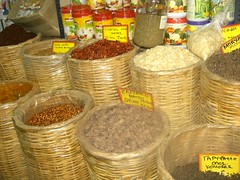
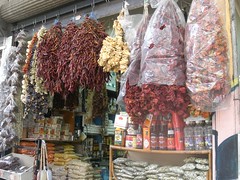
See what I mean? The grass always looks greener on the other side. The truth is you don't know how long this stuff's been hanging out in the open, but it still whets the appetite.
Walk up and down both sides of the street to see what's on offer. Watch out for the bumper to bumper traffic on the road and the wares on display on the footpath: what caught my eyes were the huge baskets of spices, rice and beans; there were even plantlets ready for potting, and crates of fresh snails popping out of their shells. Apart from the food, Evripidou is also full of specialty stores selling corks in all sizes, paper food packaging, glass jars and plastic containers, and all sorts of other bits and pieces.
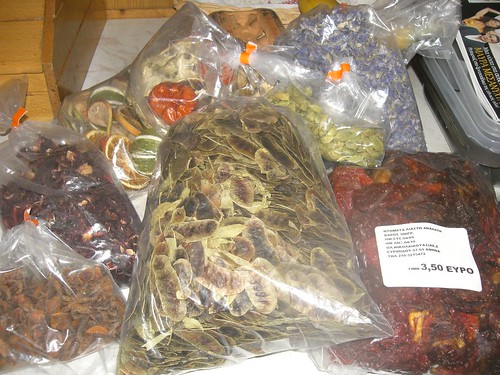
I couldn't resist the temptation of making my own pot pourri with these herbs from Evripidou. Click on the photo to see the notes.
Something doesn't feel good? The decor (or probably the lack of it)? These stores are all found in one of the most run-down neighbourhoods in central Athens. They look the same now as they did 40 years ago. Don't let that put you off; walking down Evripidou St on a busy market day is probably safer than weekends and holidays when immigrants and junkies are found loitering on the otherwise empty streets off Evripidou. I find the over-abundance of 'kinezika' (Chinese-operated clothing stores selling polyester fashion) much more off-putting than the economic migrants and derelict buildings (it's probably not the best place to be during an earthquake). As each small specialist store closes down on Evripidou St, it is re-vitalised by enterprising Chinese clothing emporium entrepreneurs (to phrase it euphemistically).
The roads neighbouring Evripidou St form one of the poorest areas of central Athens. The road itself leads to the infamous Plateia Koumoundourou (also called Plateia Eleftherias - "Freedom Square"), where the buses leave for the suburbs that make up the Western Athens district. But these same streets neighbor some of the most popular tourist sights in Athens: Psiri is a popular place to go for lunch or dinner, while Abyssinia Square (we call it Plateia Avissinias) is where the flea market takes place with an emphasis on antiques (or just plain old stuff).
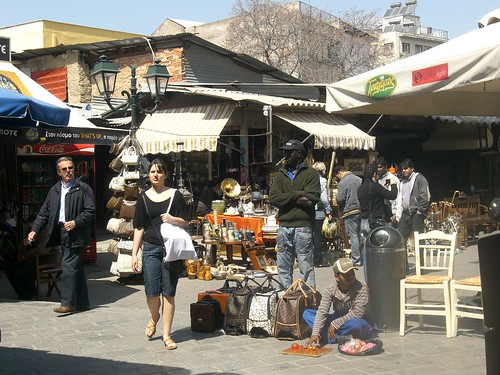

A view of Plateia Avissinias; anybody who'd visited our home in New Zealand will remember Mambo (my parents bought him in Singapore after our 1974 trip to Greece) sitting on the white crochet doily on the smallest of a set of nesting tables - here he is in Abyssinia Square.
The rock of the Acropolis is visible wherever you might find yourself in this area. It's a shame that it has had its reputation tarnished simply because economic migrants have moved into the area, and no wonder: it is situated to the west - the western districts of Athens have never been given a fair go.
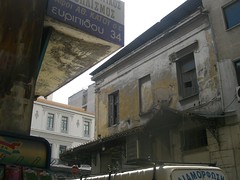
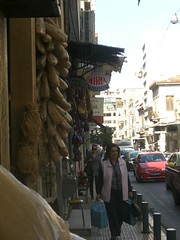
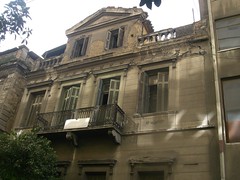
These buildings on Evripidou St were once owned by rich merchants; now they're practically lifeless, save the rats and birds that inhabit them. The lower stories are still used as shops.
On the Greek news these days, this area is under constant discussion. It is never regarded in a positive light; the issue of the immigrants is always mentioned, who are usually characterised as trouble makers. This is probably true - fights break out, trouble erupts, but usually amongst the immigrants themselves. I was not perturbed by the sight of the Pakistanis crowding inside and outside of a shop (clearly marked 'Pakistani Information Centre'), as I walked with my purse crossed over my chest, carrying three huge shopping bags down Zinonos and Bulgari Streets just before coming out onto Pireos St (which is also known as P. Tsladari, to confuse matters), where Plateia Koumoundourou is located; no one troubled me, no one talked to me, and if they looked at me, it was only so as not to bump into me while they walked on the same side of the road. The derelict buildings that have been left in a shambolic state (broken windows, the interior strewn with rubbish) on the main roads here are often those which formerly housed government offices; in other words, they are state-owned and have been left to their own fate. People can hardly be blamed if they are using these buildings as rent-free accomodation or for drug-dealing - the empty buildings were never sealed or secured in the first place. It's not a solution to have more policemen patrolling a derelict area; these buildings need to be pulled down or renovated. Desolation attracts desolates.
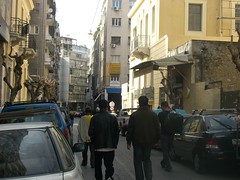
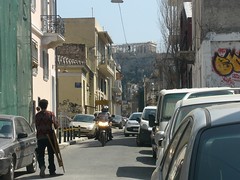
Central Athens streets near Plateia Koumoundourou, below the Acropolis; if you don't walk with confidence, you are bound to find trouble, no matter where you are.
When you've finally walked both lengths of Evripidou St, you'll find yourself back on Athinas St. It's time for another pit-stop. Walk with the Acropolis behind you, and you will eventually find yourself at Omonoia Square where there is a metro station. Take the escalator down to the underground and look at the photos depicting the square at the turn of the century. Despite the shiny stainless steel look of one of the newest underground systems in Europe, as you carry your shopping bag full of spices, you will feel (especially if you're Greek and you used to watch those old black and white Greek movies) that you had just experienced old-time Athens only a few minutes ago when you were walking along Evripidou St.
A sign from home on Evripidou St: a Cretan expat selling products from the Big Island.

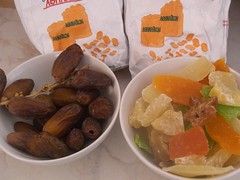
A couple more purchases from Evripidou St and the Agora in Athens: cured meat (pastrouma) and dried sugared fruit.
Come back out of the train station from the exit marked 3 September (that's the name of a road). You'll find yourself outside the Hondos Centre, a department store with a good value self-service cafe on the 10th floor with marvellous views of the Acropolis and the whole city, serving good Greek cuisine alongside international dishes. Apart from the nutritious food and the relaxing environment, it's a great place to observe the variety of people that form the citizens of Athens.
The Spice Route
This one is for you, Leonard.Just for the record, everything I bought in Athens was also available in Hania (albeit at much higher prices), but the grass always looks greener on the other side, and I felt myself succumb to the temptation of too much variety and choice...
©All Rights Reserved/Organically cooked. No part of this blog may be reproduced and/or copied by any means without prior consent from Maria Verivaki.
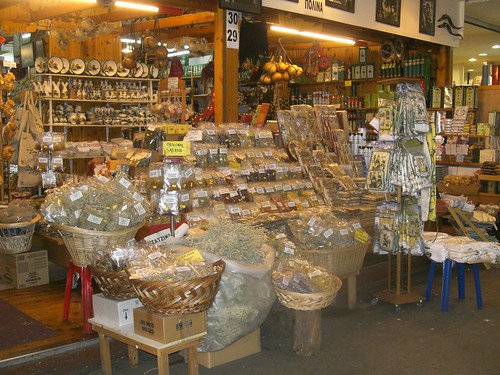
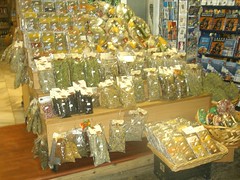
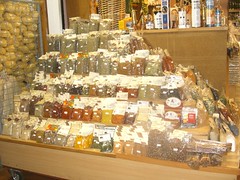
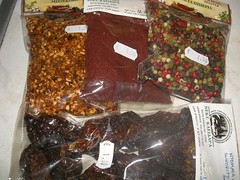

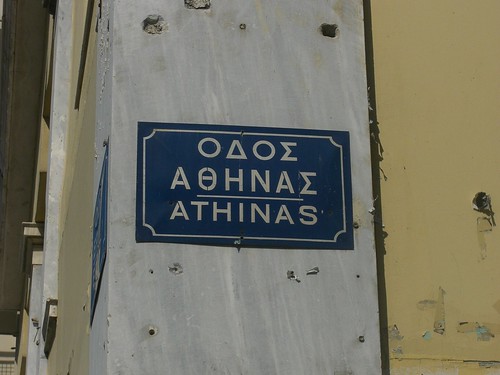

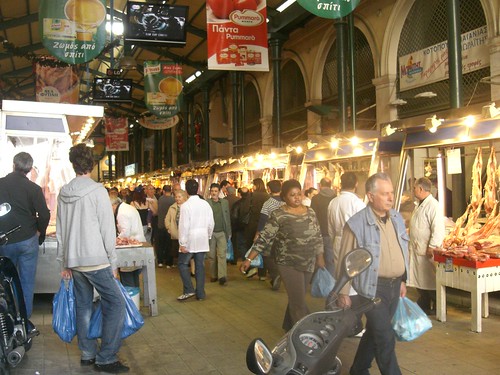
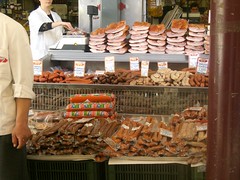

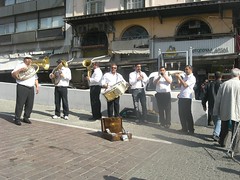
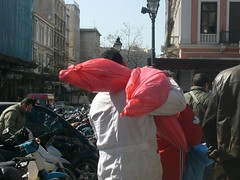
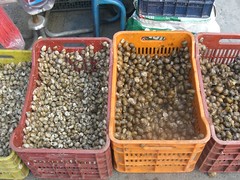
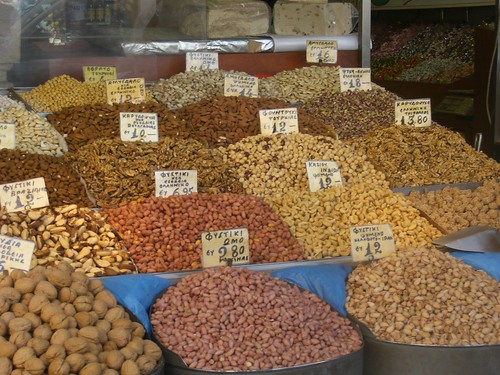
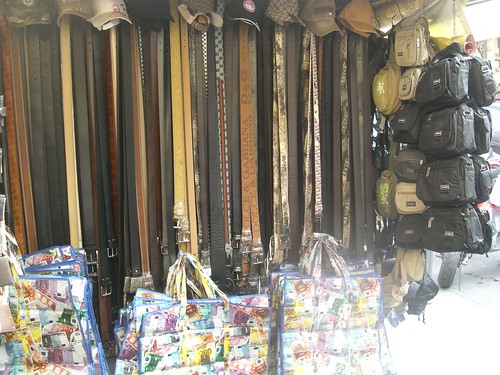

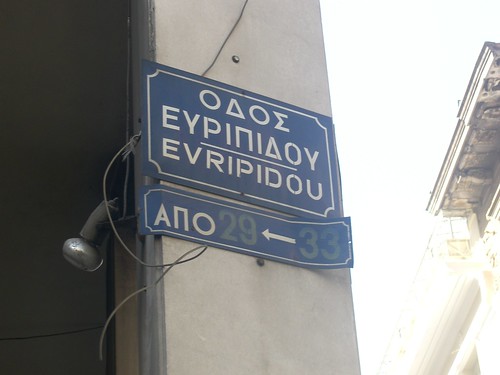

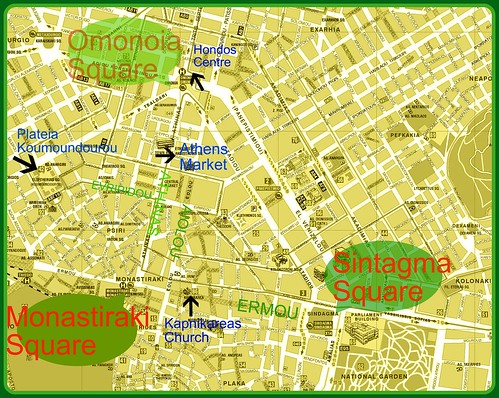
The way you write makes me miss Athens sooo much!
ReplyDeletethanks kiki, the things being said these days about athens generally turn people off our city and country, so i really appreciate your comment
ReplyDeleteI am so familiar with all those streets!! We have walked them many times. When we have nothing to do, we go for walks:)
ReplyDeleteWe didn't get to stay in Athens last summer and I am hoping to stay a couple of days this year because I personally love visiting there, especially all the neighborhoods you've highlighted.
ReplyDeleteIt's so difficult to get unpackaged foods nowadays. I agree, most people tend to buy it for the package rather than the product itself. I am with you on buying foods by touching and smelling. Nice trip in Athens.
ReplyDeleteAhhh, Maria, you are right - I loved this one and so wished I was walking along side you. We would have so much fun! You've featured some of my favorite places in the entire world - I never get tired of Ermou, Athinas, and Evripidou. Great pictures, evocative descriptions. Maybe you'll be ready for another stroll in September...
ReplyDeleteGreat, thanks, I'll try to remember everything you've said....Do you think Iraklion market is any good? Like you, I always wonder how long the spices have been around.
ReplyDeleteIt was exactly this time of year 3 years ago that I walked these very streets of Athens. I drank my first iced coffee at an establishment right next to the Byzantine church. Sadly I never made it to the market. I really need to have a better internal GPS to navigate:D
ReplyDeleteFantastic text and amazing pictures! Well done Maria, traveller!!
ReplyDeleteYou showed a photo of the meat section of the market. In the old days, when I went to Athens I often ate lunch in the meat market. There are places inside, mainly for the workers, that sell serious Greek meat dishes - like my favourite - youvetsi at very reasonable prices. The last time I was there, it was blazing hot outside. In the cavernous space with animal carcasses hanging from every shop front, it was blissfully cool. In the restaurant, the old man brought a metal pitcher of retsina from the barrel, its sides beaded with condensation before I ordered anything. He just knew that I needed it.
ReplyDeleteThank you for this wonderful spice route. You got enough bay leaves to last you for five years?? I've just bought a 10g package of them, for almost 3 euros... (snif, snif)
ReplyDeleteI couldn't believe my eyes when seeing the prices of those spices!
I love the spice route!
ReplyDeleteThanks for sharing your journey with us!
Needed bay leaves? I have 3 trees...next time hit me up! :)
A fabulous and detailed tour of the city, spices, the smells, the noise, the haggling for prices...love it!
ReplyDeleteSave for "emborika kentra", these outdoor street markets are like amusement parks, never tire of them.
So many wonderful sights, and I can almost smell all those spices.
ReplyDeleteThank you for this virtual tour! Once again, I appreciate that you don't gloss over the less-appealing or -attractive parts of the city. The array of foods is truly amazing and seeing them displayed in this manner really does underscore how packaging obscures our perceptions.
ReplyDeleteI lived for six years in Athens and coming from a nearby city i jumped at every opportunity to visit it. I simply like it, both its dirty and shiny white parts.
ReplyDeleteThe city is full of treasure, i hope i have the chance to write about it at some point.
Traffic jams? So what, you are never going to make it on time ANYWAY....so why curse and yell? Relax and enjoy it :-D
Those spice stores are amazing! I've never seen anything like them here. I'm moving. That's final.
ReplyDelete